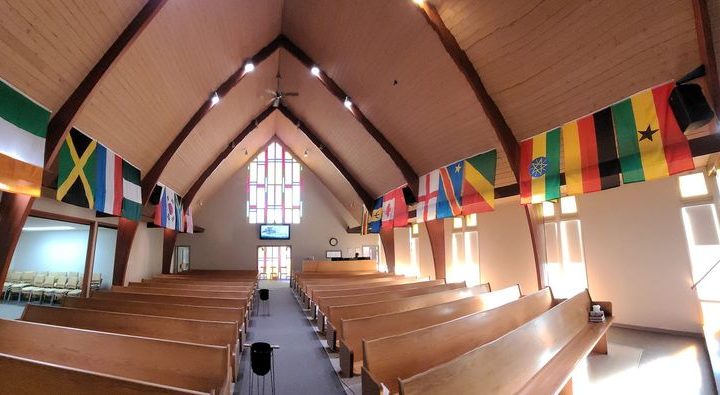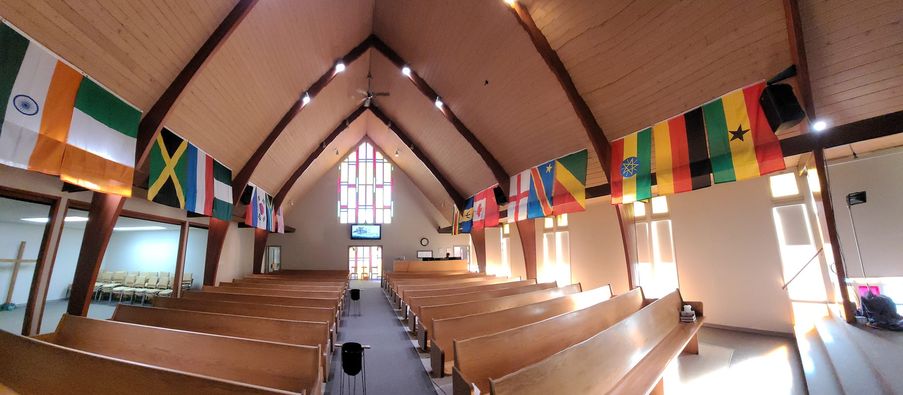In mid-September, I returned to the church of my childhood, McLaurin Memorial Baptist Church in Edmonton, Alberta. The last time I had been inside the church was for the 1998 funeral of my mother.
There are still a handful of people at McLaurin who remembered me, but the congregation has changed radically. The choir loft and the organ have been replaced by a keyboard, a drum kit and five microphones strung across the stage for the worship team. The bass-playing pastor handed me a guitar and asked me to strum along. Given the evolution of evangelical worship, none of this came as a total surprise.

Alan Bean
Here’s what I didn’t expect: The church of my childhood is now minority white. At least half the congregation is comprised of immigrants from Nigeria, the Ivory Coast, Zimbabwe, Congo, Ethiopia and Ghana. The church also has members from the United States, Great Britain, Korea, India, Germany and Jamaica. The sanctuary is festooned with the flags of these 14 nations.
As soon as the Baptists have left the building, a Korean Presbyterian congregation arrives for worship.
McLaurin’s transformation fills me with hope and joy. Since childhood, I have seen our racially divided Christendom as a symptom of a deep, and largely unacknowledged, pathology. This sense of disquiet helps explain the racial justice work that has occupied the last quarter century of my life. This column is my attempt to reckon with the implications of a rapidly changing world for liberal white Christians like me.
Christian growth in Africa
The African church is exploding. In 1900, fewer than 10 million Christians inhabited the continent. By 2000, there were 350 million, and that number is expected to grow to at least 630 million by 2025. The growth of African Christianity is partly fueled by evangelism, but the big driver is population growth. Uganda, for instance, had a population of 5.5 million people in 1950; it is projected that, by 2050, there will be 80 million Ugandans.
The white population of Europe and North America is static and, in many places, declining. The prevalence of marriage is dropping, young people are marrying later, and family size is declining. Not so in Africa. While Western theology focuses on the individual, African religion (both Christian and Muslim) emphasizes the family unit. As a consequence, the Western critique of patriarchy and homophobia are typically rejected as unwanted innovations from the secular West.
The explosive growth of African Christianity is having a profound impact on Roman Catholic, Methodist and Anglican communions in Britain, Canada and the United States. Facing pressure from the liberal wing of Western Christianity to eschew opposition to the ordination of LGBTQ Christians and women, denominations with a worldwide constituency face pushback from African leaders.
“Large African congregations are springing up across the Western world.”
Large African congregations are springing up across the Western world. The four largest megachurches in Great Britain, for instance, are Nigerian. As the population of the West shrinks and ages, the sons and daughters of Africa, most of them Christian, are emigrating to Europe, Canada and the United States.
Although Africa has no shortage of liberation theologians calling for the Africanization of Christianity, the impact of this thinking, at the popular level, is most apparent in evolving styles of worship and a preference for native dress on Sunday mornings.
The most dramatic church growth within the African church has been within non-denominational, charismatic churches, many of which have been deeply influenced by ideas such as “the prosperity gospel” and “dominionism” that have been marketed by the most radical expressions of American evangelicalism.
A rapidly expanding Christianity naturally worships an all-powerful, wonder-working God while embracing exuberant, celebrative forms of worship.
Liberal white Christians are very different
The mindset of white liberal Christianity couldn’t be more different. As Jeremiah Wright (echoing Malcom X) so famously predicted, our chickens are coming home to roost. In a 1965 essay written for Ebony, James Baldwin lamented the refusal of white Americans to familiarize themselves with their own history. “One wishes that Americans, white Americans, would read, for their own sakes, this record, and stop defending themselves against it. Only then will they be enabled to change their lives.”
The tragic reality, Baldwin said, was that white people believe they are responsible for their lot in life while too many Black children erroneously believe they are to blame for their own misfortune.
As evidenced by the Black Lives Matter movement, the situation Baldwin described is beginning to change, at least for young Black people. And, here and there, a few white Americans are getting with the program. Which is why conservative white people are freaking out about Critical Race Theory” and “the woke agenda.”
“All forms of over-under hierarchy are currently subject to review and revision.”
And, as Baldwin clearly understood, it isn’t just about race. All forms of over-under hierarchy are currently subject to review and revision: patriarchy, homophobia, transphobia, white supremacy, Western colonialism, and capitalism.
As a general rule, congregations sympathetic to the plight of the Black church (whether in America or in Africa) skew to the liberal end of the theological spectrum. These churches tend to be formal, liturgical in worship. We express our faith in cautious whispers. An all-powerful God is in the business of elevating faithful nations and debasing sinful peoples. We prefer a suffering God who works primarily through human love and is blocked at every turn by our arrogant waywardness.
In many respects, the theology and the boisterous, praise-oriented worship of white evangelical megachurches is much closer to the preaching and worship style of Black churches, both African and African American. Which helps explain why the big-city megachurches lodged at the intersection of major thoroughfares often display more racial diversity than you will find in your average big-steeple liberal congregation.
“Big-city megachurches lodged at the intersection of major thoroughfares often display more racial diversity than you will find in your average big-steeple liberal congregation.”
Our reflective, even somber, way of worshipping God, and our cautious, even halting, way of addressing God, also stands in marked contrast to the Black church in America. A recent Pew study found that 72% of Black Millennials believe in God without question, compared to just 46% of white respondents of the same age. While 21% of young white Millennials identify as atheist, this was true of only 3% of young Black Millennials. Similarly, 42% of Black young Millennials attend worship at least once a week compared to just 26% of their white peers. And 52% of Black respondents said religion was “very important” in their lives compared to just 34% of whites.
African Christians are devout
A 2021 Pew study found African Christians are even more devout than African Americans. Moreover, the rapid decline of religious practice among young American white people is hardly noticeable among Black young people.
Young Black people in America might not be attending worship or praying quite as much as their parents and grandparents, but they value and respect the historically Black church. The massive flight of young people from religious faith is most apparent, the study found, among the most “woke” portion of the young white population.
Religion, many young people have come to believe, is hopelessly entangled in the systematic abuse of power. This is a minority view, even among liberal young white people, but it is gaining traction.
Real history
Meanwhile, conservative white America continues to reject Baldwin’s invitation to get real about American history, and this is reflected in their religious views. You will not be surprised to learn that 72% of white Republicans, for instance, continue to believe in “God as described in the Bible” compared to just 32% of white Democrats. The flight of liberal whites from organized religion is much less prominent among conservative whites, especially in the Southern states where evangelicalism has become synonymous with Republicanism.
“The Millennial and Gen Z cohorts appear more liberal than older generational cohorts largely because they are much less white.”
White young people are more liberal than their parents on social issues like gay rights and pot legalization, but racial attitudes, depressingly, haven’t changed that much. The Millennial and Gen Z cohorts appear more liberal than older generational cohorts largely because they are much less white.
For generations, the white population of the United States hovered between 83.8% (1850) and 88.3% (1940). Since 1970, however, the white population has plummeted from 83.5% to a current 57.8%. That’s a drop of 25.7 percentage points.

Bayside Community Church, Bradenton, Fla. (Photo by Nathan Mullet on Unsplash)
Somewhere between 2041 and 2046, the United States will become a majority-minority nation. That day has almost arrived for Millennials (40% of whom are non-white), and already has arrived for children under 14. No wonder white conservatives are freaking out!
Liberal white congregations could hardly be described as bastions of wokeness, but we are beginning to reckon with our chickens. Has our reappraisal of history shaken our faith? Of course. How could it not? Has it shaken our confidence? Of course, it has. In fact, it has rocked us back on our ecclesial heels.
In his 1965 Ebony essay, Baldwin asserted that “people who imagine that history flatters them (as it does, indeed, since they wrote it) are impaled on their history like a butterfly on a pin.” Ironically, it is the white liberal Christians who feel impaled upon the very history our parents celebrated. And the only way to heal our wound is to acknowledge, before God, the full dimension of our plight.
Whether we recognize it or not, the condition of the white churches of America is straight out of Lamentations:
Your prophets have seen for you false and deceptive visions;
they have not exposed your iniquity to restore your fortunes
but have seen oracles for you that are false and misleading.
“The white churches of America are walking the weary road into exile.”
Walking the weary road to exile
In short, the white churches of America are walking the weary road into exile. We may refuse to believe it, but this is precisely where God wants us to be. The somber, liturgical forms of worship to which we are drawn reflect our emotional needs and our circumstance. This is no time for triumphal celebration. It is a time for reflective contemplation and a slow, gradual process of repentance.
And we’re just getting started.
White Christians who attempt to mimic the celebratory spirit and bold confidence of Black churches are bound to look ridiculous. We’ve had our day in the sun, we’ve squandered it badly, and now we must reckon with ruin. White Christian nationalism is idolatrous to the core. It’s also silly. God has a beef with white Christian America, and we won’t see the light of glory until we acknowledge the chickens roosting around us.
Once-proud white churches aren’t dying; they’re engaged in a long, twilight journey into exile. If we embrace our condition, God will send a few Black sisters and brothers to walk us through the valley of the shadow. Its scary new terrain for us; but for them, it’s familiar territory.
Alan Bean is executive director of Friends of Justice, an alliance of community members that advocates for criminal justice reform. He lives in Arlington, Texas.


